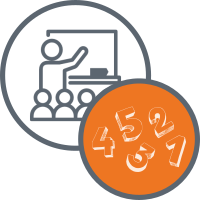You are here
Effective Mathematics Teaching Practice 6: Build Procedural Fluency from Conceptual Understanding
Instructional Support Menu
Build Procedural Fluency from Conceptual Understanding
Some mathematics teachers falsely believe that students must first master “the basics” before engaging in more complex ideas. A substantial portion of research in mathematics education has shown this belief to not only be false, but to be damaging to the mathematical futures of students. When used this way, “the basics” is usually a term referring to mastery of procedures and knowing facts from memory. While procedural fluency and knowing facts is an indispensable part of learning mathematics, students who understand the concepts underlying the procedures and facts have been shown to learn procedures and facts more readily, use them more flexibly, and better retain their skills better over time (Fuson, Kalchman, & Bransford, 2005; National Mathematics Advisory Panel, 2008).
Effective teaching of mathematics builds fluency with procedures on a foundation of conceptual understanding so that students, over time, become skillful in using procedures flexibly as they solve contextual and mathematical problems.
-NCTM (2014), p. 42
The Practice in Action
One of the ways NCTM (2014, pp. 47-48) summarizes the practice of build procedural fluency from conceptual understanding is by describing a set of actions expected of teachers and students that indicate engagement in this teaching practice.
Caution! Don't over-estimate your own understanding based on these brief descriptions of teaching practice. Professional educators should dig more deeply into NCTM's resources, join study groups and professional networks, and seek out professional development and coaching to ensure high-quality engagement in the practice.
What are teachers doing?
- Providing students with opportunities to use their own reasoning strategies and methods for solving problems.
- Asking students to discuss and explain why the procedures that they are using work to solve particular problems.
- Connecting student-generated strategies and methods to more efficient procedures as appropriate.
- Using visual models to support students’ understanding of general methods.
- Providing students with opportunities for distributed practice of procedures.
What are students doing?
- Making sure that they understand and can explain the mathematical basis for the procedures that they are using.
- Demonstrating flexible use of strategies and methods while reflecting on which procedures seem to work best for specific types of problems.
- Determining whether specific approaches generalize to a broad class of problems.
- Striving to use procedures appropriately and efficiently.
Resources
- Principles to Action: Ensuring Mathematical Success for All (NCTM, 2014, pp. 42-48)
- Taking Action: Implementing Effective Mathematics Teaching Practices in K-Grade 5 (NCTM, 2017, pp. 67-95)
- Taking Action: Implementing Effective Mathematics Teaching Practices in Grades 6-8 (NCTM, 2017, pp. 55-76)
- Taking Action: Implementing Effective Mathematics Teaching Practices in Grades 9-12 (NCTM, 2017, pp. 49-69)
- Enhancing Classroom Practice with Research behind Principles to Actions (NCTM, 2017, pp. 61-72)
- Catalyzing Change in Middle School Mathematics (NCTM, 2020, p. 61)
- Mathematical Understanding: An Introduction in How Students Learn: Mathematics in the Classroom (Fuson, Kalchman, & Bransford, 2005)
- Foundations for Success: The Final Report of the National Mathematics Advisory Panel (National Mathematics Advisory Panel, 2008)




Connect With Us




